Influencer marketing has emerged as a powerful tool for enhancing brand visibility by tapping into the established audiences of social media personalities. By creating authentic content that resonates with targeted demographics, brands can effectively engage new customers and foster meaningful interactions that drive loyalty and conversions. Selecting the right influencers whose values align with a brand’s mission is crucial for maximizing these benefits and ensuring successful partnerships.
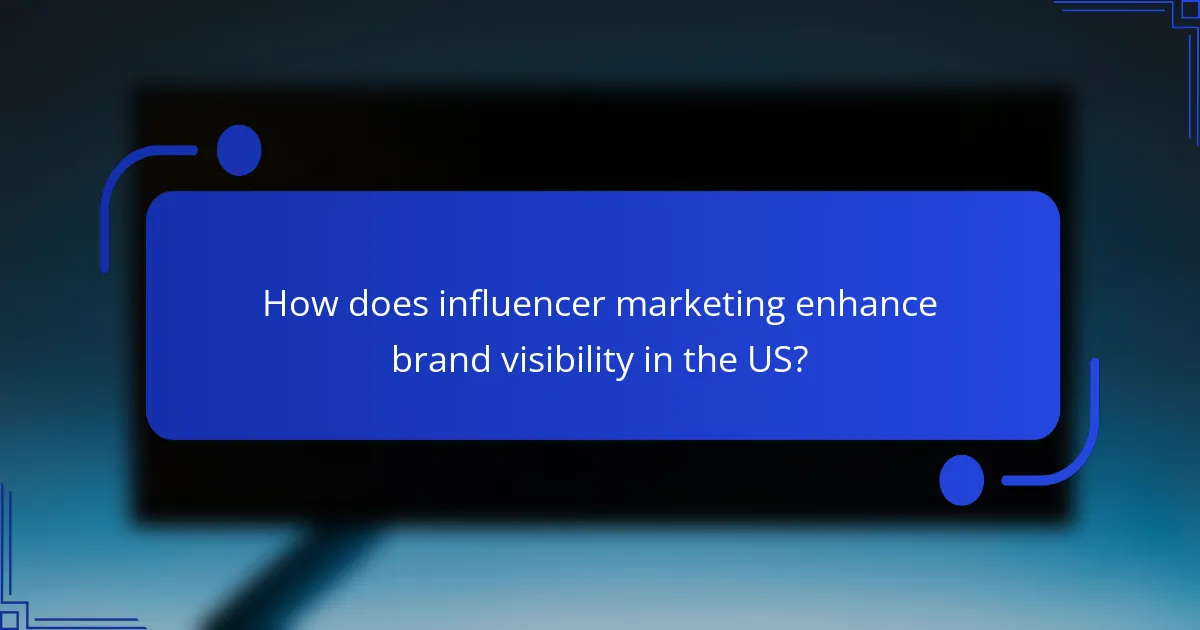
How does influencer marketing enhance brand visibility in the US?
Influencer marketing significantly boosts brand visibility in the US by leveraging the established audiences of social media personalities. Brands can reach new customers effectively through authentic content that resonates with targeted demographics.
Increased reach through social media platforms
Influencer marketing allows brands to tap into the vast audiences of platforms like Instagram, TikTok, and YouTube. By collaborating with influencers who have substantial followings, brands can achieve exposure to millions of potential customers, often at a fraction of traditional advertising costs.
For instance, micro-influencers, who typically have between 1,000 and 100,000 followers, can provide highly engaged audiences. This targeted approach often results in better engagement rates compared to broader campaigns.
Boosted brand credibility via trusted endorsements
When influencers endorse a brand, they lend their credibility and trustworthiness to that brand, which can significantly enhance its reputation. Consumers are more likely to trust recommendations from individuals they follow and admire rather than traditional advertisements.
To maximize this effect, brands should select influencers whose values align with their own. Authentic partnerships lead to more genuine endorsements, which can result in higher conversion rates and long-term customer loyalty.
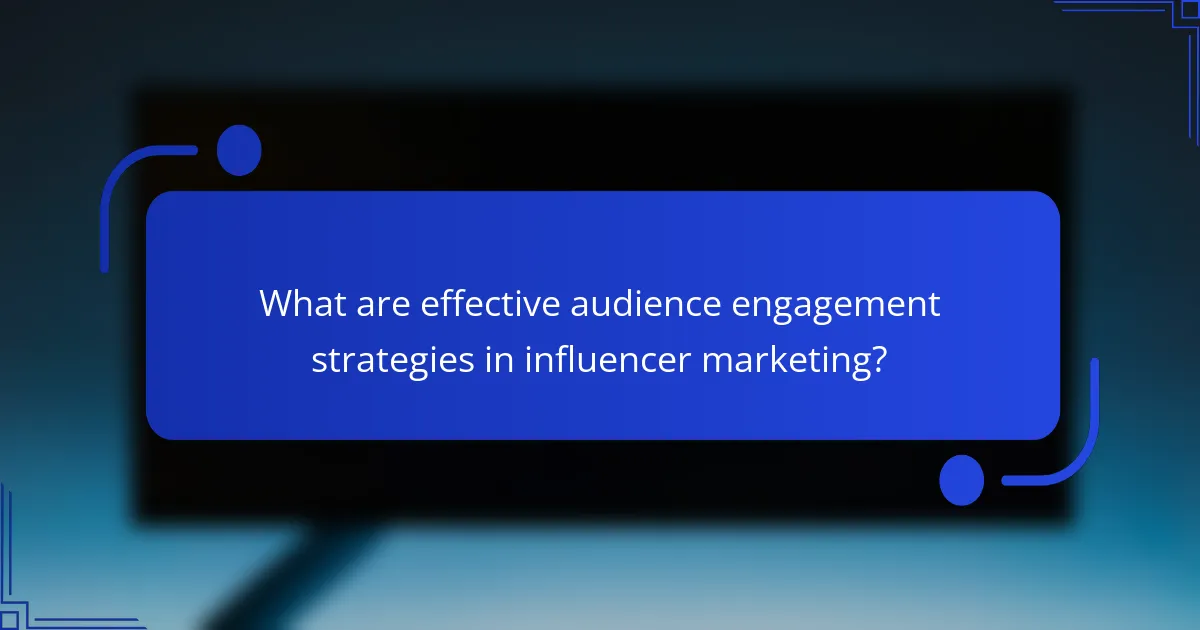
What are effective audience engagement strategies in influencer marketing?
Effective audience engagement strategies in influencer marketing focus on creating meaningful interactions between brands and their target audiences. These strategies enhance brand visibility and foster a sense of community, ultimately driving customer loyalty and conversions.
Interactive content creation
Interactive content creation involves developing engaging materials that encourage audience participation. Examples include quizzes, polls, and contests that not only entertain but also gather valuable insights about consumer preferences.
To implement this strategy, brands should collaborate with influencers to design content that resonates with their followers. For instance, a beauty brand might partner with an influencer to create a makeup challenge, inviting followers to share their looks using a specific hashtag.
Key considerations include ensuring the content aligns with the influencer’s style and audience interests. Avoid overly complex interactions that may deter participation; simplicity often leads to higher engagement rates.
Live streaming events with influencers
Live streaming events with influencers provide real-time interaction opportunities, allowing brands to showcase products and engage directly with their audience. These events can include Q&A sessions, product launches, or behind-the-scenes glimpses that create a sense of exclusivity.
When planning a live stream, select an influencer whose audience matches your target demographic. Promote the event across social media channels to maximize reach. During the stream, encourage viewers to ask questions and share their thoughts to foster engagement.
Be mindful of timing and platform choice; popular platforms like Instagram Live or YouTube can attract larger audiences. Ensure technical aspects are tested beforehand to avoid disruptions during the event, which could negatively impact viewer experience.
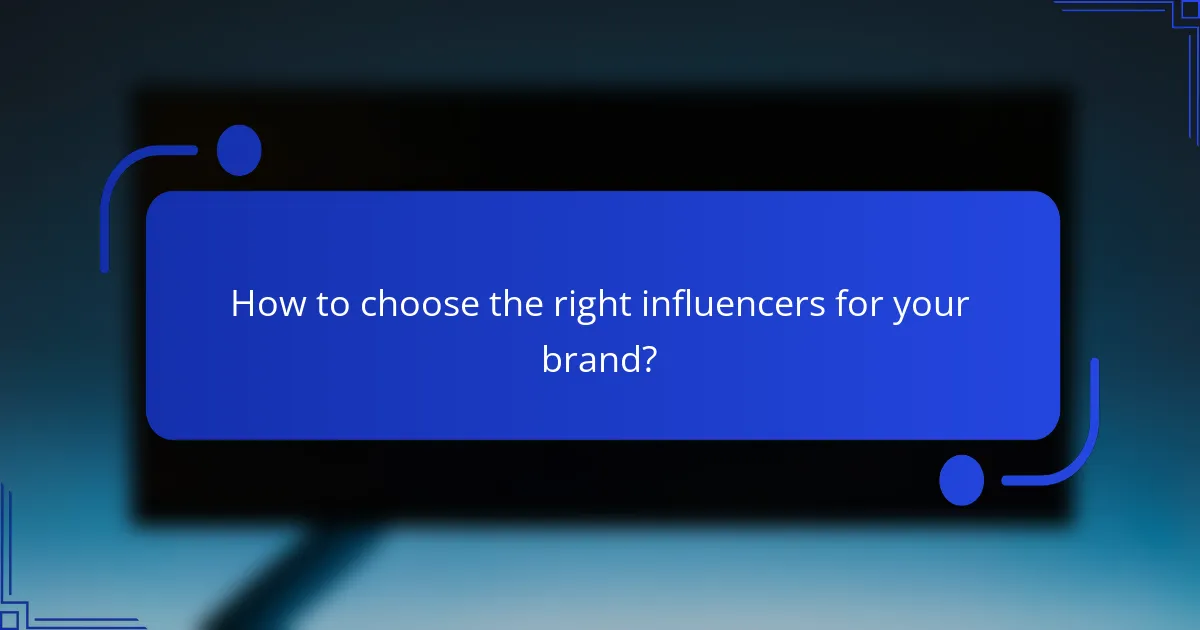
How to choose the right influencers for your brand?
Choosing the right influencers for your brand involves identifying individuals whose values and audience align with your brand’s mission. This selection process can significantly enhance your visibility and engagement with potential customers.
Alignment with brand values
Ensuring that an influencer’s values resonate with your brand is crucial for authentic partnerships. Look for influencers who consistently promote messages and lifestyles that reflect your brand’s ethos. For example, if your brand focuses on sustainability, partnering with eco-conscious influencers will create a more genuine connection with your target audience.
To assess alignment, review the influencer’s content, past collaborations, and audience interactions. A strong alignment can lead to more effective campaigns and foster trust among consumers.
Engagement metrics over follower count
Prioritizing engagement metrics, such as likes, comments, and shares, is more effective than simply looking at follower counts. An influencer with a smaller but highly engaged audience can deliver better results than one with a large but passive following. Aim for influencers whose engagement rates fall within the average range of 1% to 5% for their niche.
When evaluating potential influencers, consider their audience demographics and the quality of interactions. Tools like social media analytics can provide insights into engagement levels, helping you make informed decisions about partnerships.
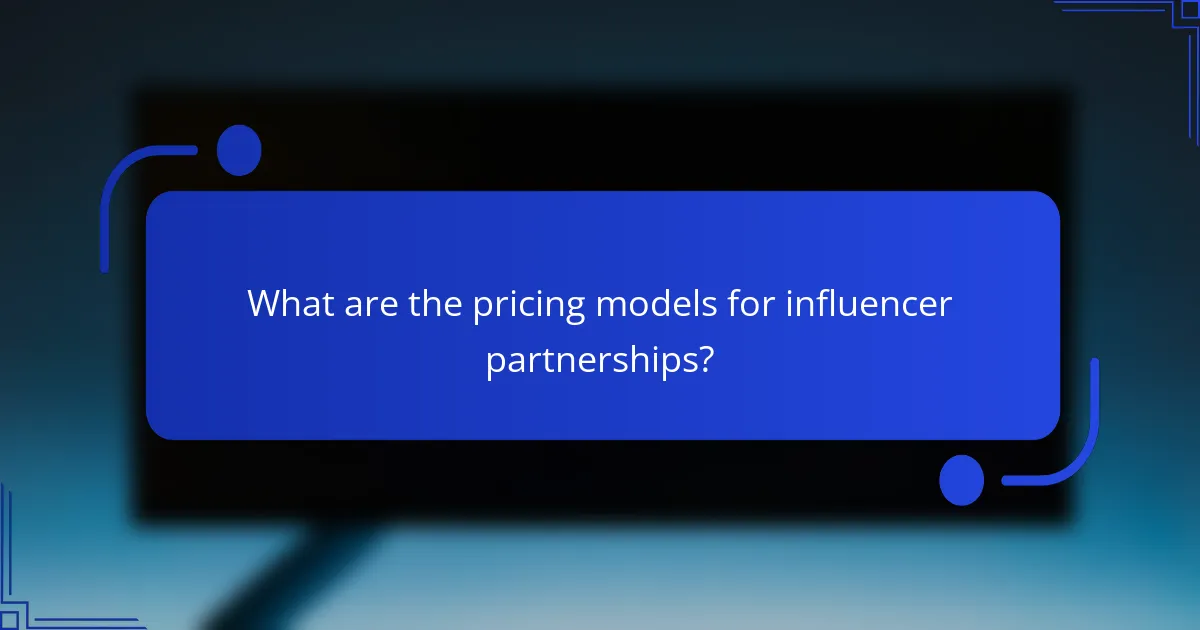
What are the pricing models for influencer partnerships?
Influencer partnerships typically utilize various pricing models to determine compensation. The most common models include pay-per-post arrangements and commission-based models, each offering distinct advantages and considerations for brands.
Pay-per-post arrangements
Pay-per-post arrangements involve brands paying influencers a fixed fee for each post they create promoting a product or service. This model is straightforward and allows brands to budget effectively, as costs are predictable.
When considering pay-per-post, brands should evaluate the influencer’s reach and engagement rates. Fees can vary widely, generally ranging from a few hundred to several thousand dollars per post, depending on the influencer’s audience size and niche.
Brands should ensure that the content aligns with their messaging and values. Clear agreements on deliverables, timelines, and content guidelines are essential to avoid misunderstandings.
Commission-based models
Commission-based models compensate influencers based on the sales they generate through their promotional efforts. This performance-based approach can be beneficial for brands looking to maximize their return on investment.
In this model, influencers typically receive a percentage of sales made through unique affiliate links or discount codes. Commission rates often range from 5% to 30%, depending on the product and agreement terms.
Brands should track sales accurately and provide influencers with the necessary tools to promote effectively. Clear communication about expectations and performance metrics is crucial to ensure a successful partnership.
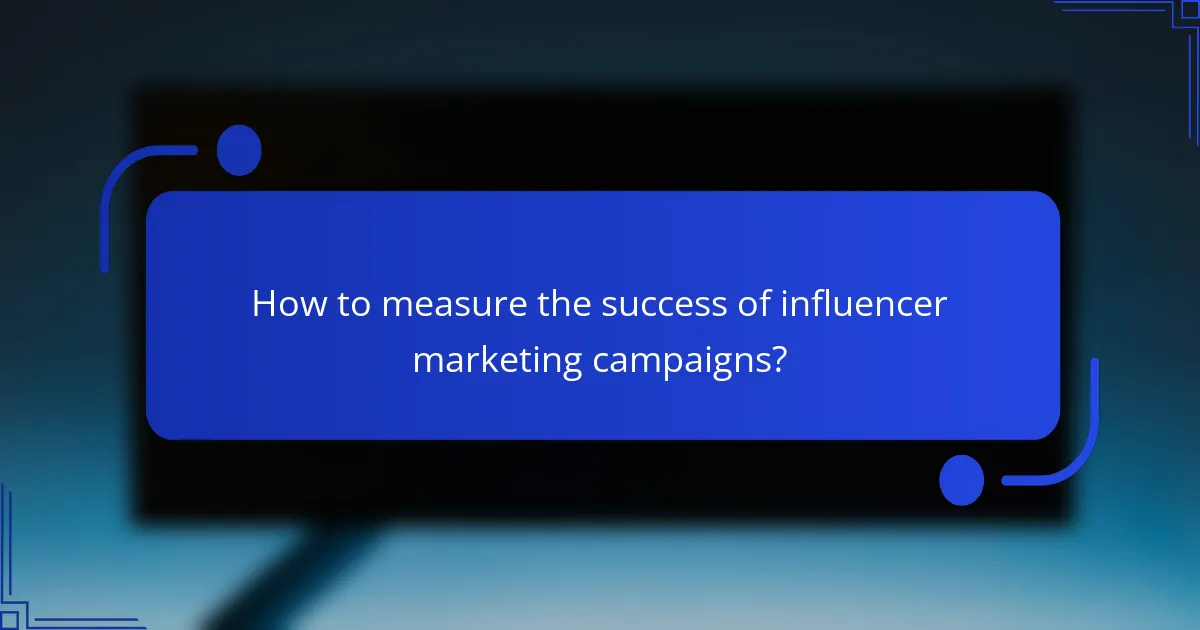
How to measure the success of influencer marketing campaigns?
Measuring the success of influencer marketing campaigns involves evaluating key performance indicators (KPIs) such as engagement rates and conversion metrics. These metrics provide insights into how well the campaign resonates with the target audience and its effectiveness in driving desired actions.
Tracking engagement rates
Engagement rates reflect how actively the audience interacts with the influencer’s content. This can include likes, shares, comments, and overall reach. A strong engagement rate typically ranges from 1% to 5%, but this can vary based on the platform and industry.
To track engagement effectively, use analytics tools provided by social media platforms or third-party services. Monitor trends over time to identify which types of content generate the most interaction. Be cautious of inflated numbers from bots or fake accounts, which can skew results.
Analyzing conversion metrics
Conversion metrics measure the effectiveness of an influencer campaign in driving specific actions, such as website visits, sign-ups, or purchases. Common conversion rates for influencer campaigns can range from 1% to 10%, depending on the product and audience alignment.
To analyze conversions, set up tracking links or use unique promo codes for each influencer. This allows for precise measurement of how many conversions stem from the campaign. Regularly review these metrics to optimize future collaborations and adjust strategies based on what works best for your brand.
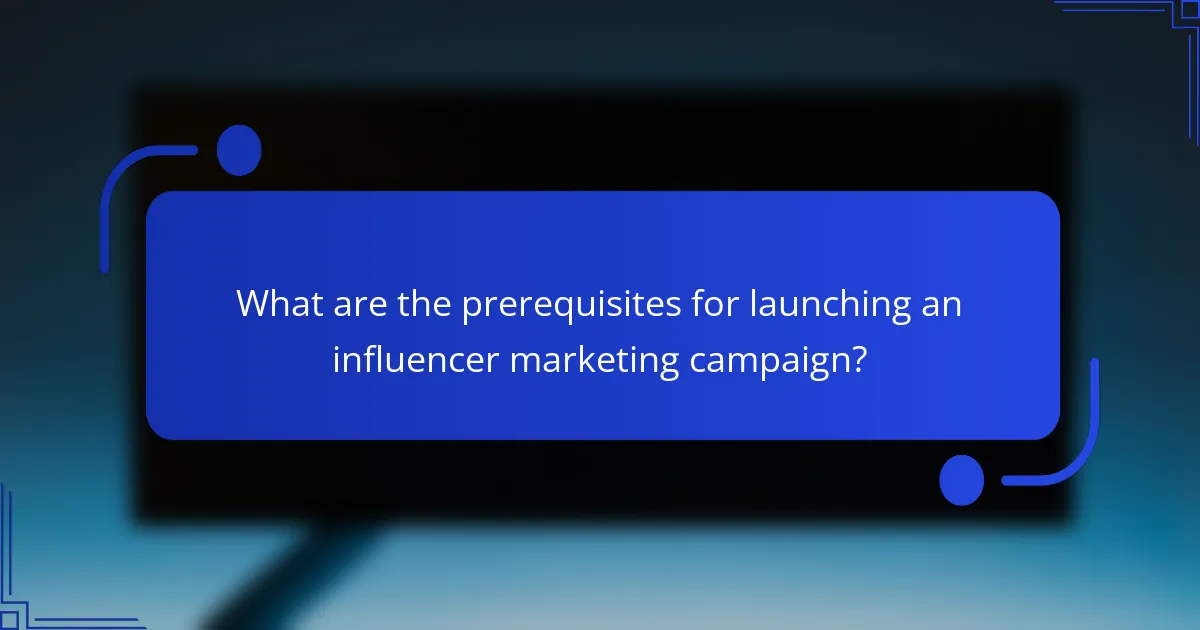
What are the prerequisites for launching an influencer marketing campaign?
To successfully launch an influencer marketing campaign, brands must establish clear campaign objectives and define their target audience. These prerequisites ensure that the campaign is focused, measurable, and effectively reaches the desired consumers.
Clear campaign objectives
Establishing clear campaign objectives is essential for guiding the influencer marketing strategy. Objectives can include increasing brand awareness, driving website traffic, or boosting sales. Each goal should be specific, measurable, achievable, relevant, and time-bound (SMART).
For example, a brand might aim to increase social media followers by 20% within three months through influencer partnerships. This clarity helps in selecting the right influencers and measuring the campaign’s success.
Defined target audience
Defining a target audience is crucial for effective influencer marketing. Brands should identify demographics such as age, gender, location, and interests to ensure alignment with the influencers’ followers. This alignment increases the likelihood of engagement and conversion.
For instance, a skincare brand targeting young adults may collaborate with influencers who have a strong presence among this age group on platforms like Instagram or TikTok. Understanding the audience helps in crafting relevant messages that resonate with potential customers.

What are common pitfalls in influencer marketing?
Common pitfalls in influencer marketing include misalignment between the brand and influencer audiences, as well as overlooking critical contract details. These mistakes can lead to ineffective campaigns and wasted resources.
Choosing influencers without audience alignment
Selecting influencers whose audiences do not match your target demographic can severely limit the effectiveness of your marketing efforts. Brands should analyze the influencer’s follower demographics, engagement rates, and content style to ensure compatibility.
For example, if a skincare brand partners with an influencer primarily known for fitness, the audience may not be interested in skincare products. Use tools like social media analytics to assess audience overlap before finalizing partnerships.
Neglecting contract details
Failing to address contract specifics can lead to misunderstandings and unmet expectations. It’s crucial to outline deliverables, timelines, compensation, and usage rights clearly in the agreement.
For instance, if an influencer is expected to create a series of posts but the contract only specifies one, the brand may be disappointed with the results. Always review contracts carefully and consider including clauses that protect both parties, such as performance metrics and content approval processes.
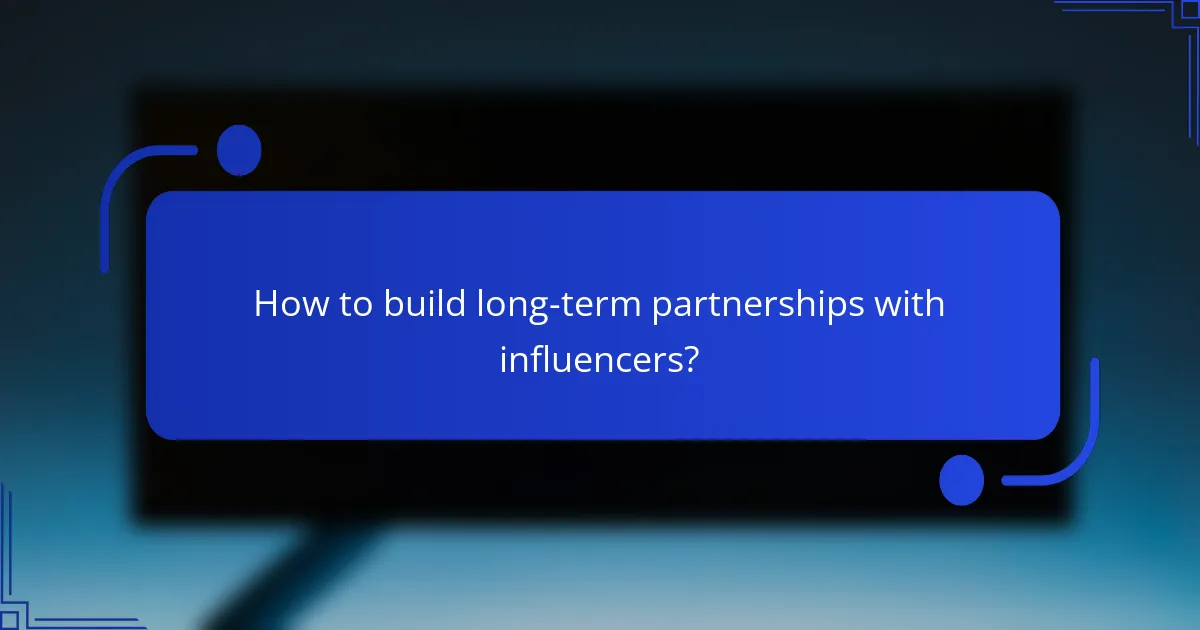
How to build long-term partnerships with influencers?
Building long-term partnerships with influencers involves creating mutually beneficial relationships that extend beyond one-off campaigns. Focus on aligning brand values with the influencer’s audience and content style to foster authentic connections.
Identify the right influencers
Select influencers whose audience aligns with your target market. Look for individuals who share similar values and have a genuine connection with their followers. Tools like social media analytics can help you assess engagement rates and audience demographics.
Consider micro-influencers as they often have higher engagement rates and more niche audiences. Collaborating with them can lead to more authentic interactions and a stronger brand presence.
Establish clear expectations
Define the goals of the partnership, including deliverables, timelines, and compensation. Clear communication helps prevent misunderstandings and ensures both parties are aligned on objectives.
Draft a contract that outlines the terms of the collaboration, including content guidelines and usage rights. This formal agreement protects both the brand and the influencer.
Foster ongoing communication
Maintain regular contact with influencers to build rapport and trust. Share updates about your brand and involve them in new product launches or campaigns to keep them engaged.
Encourage feedback from influencers about their experiences and your products. This two-way communication can lead to valuable insights and strengthen the partnership.
Measure and optimize performance
Track the performance of influencer campaigns using metrics such as engagement rates, reach, and conversions. Analyzing these results helps you understand what works and what doesn’t.
Use this data to refine your approach and make informed decisions about future collaborations. Regularly assess the partnership’s effectiveness to ensure it continues to meet both parties’ goals.
